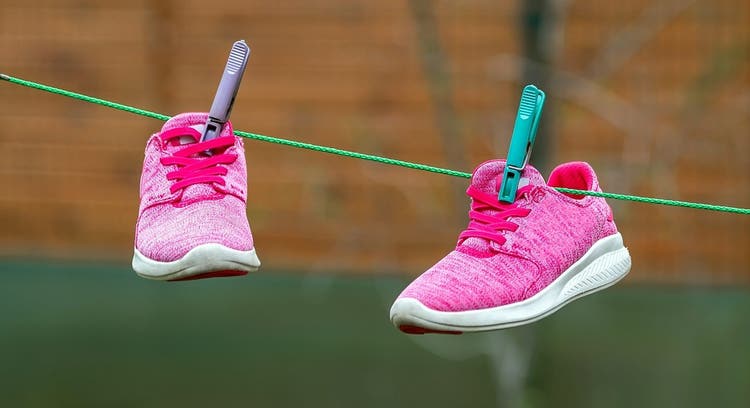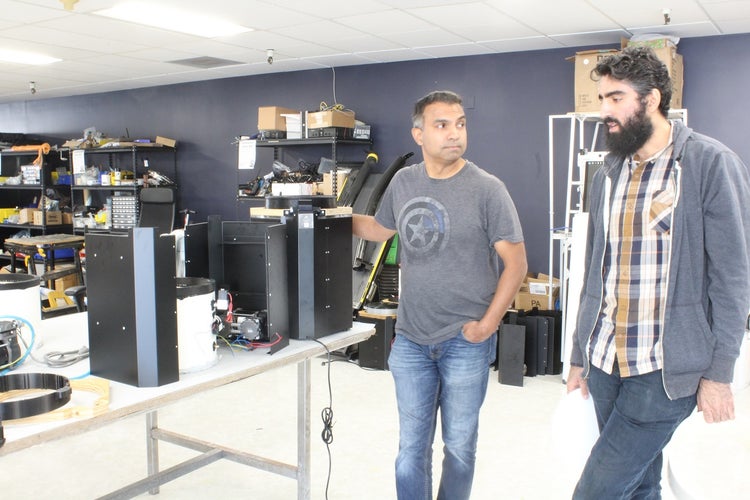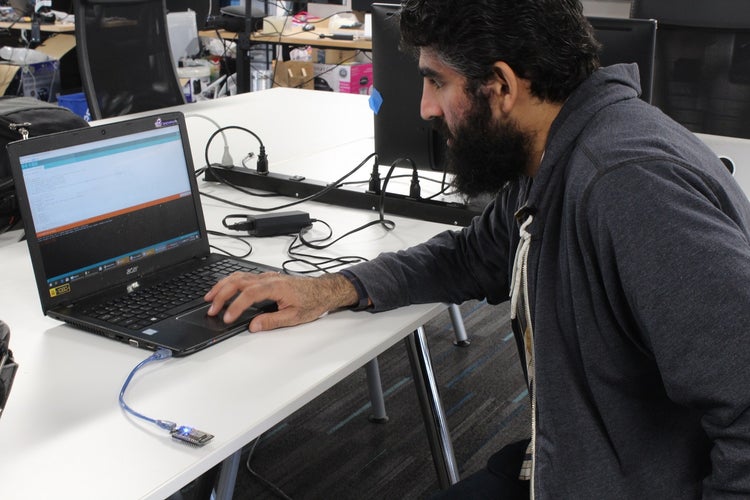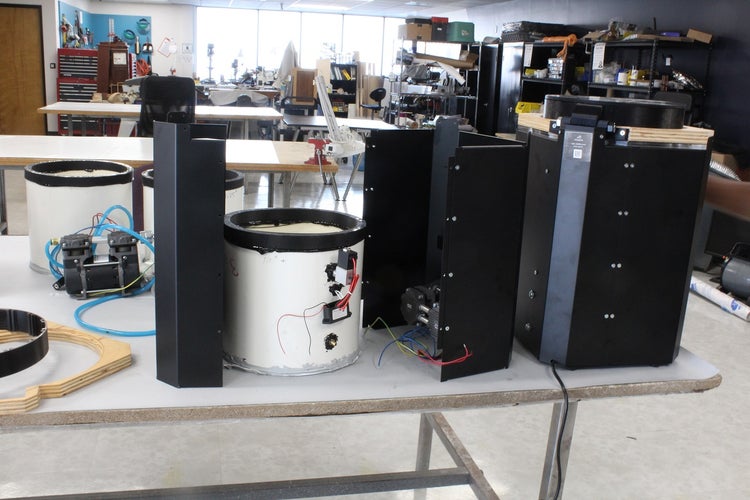Revolutionizing Your Laundry

Amir Khazaieli says he figured out he was spending too much time in the lab as an engineering student, when it came time to do his laundry.
Like many of us buried deep in a project, Khazaieli admits he wore the same clothes each day, like his synthetic fabric jacket and shirt. And like many of us clad in our working-on-a-project uniforms, Khazaieli noticed he couldn’t get his body odor out of his shirts and jackets using detergent and a washing machine.
That’s when he began his personal dissertation on the state of laundry. His key discovery: “Laundry’s been the same since 1935,” Khazaieli says.
Yet fabrics making that clothing have changed a lot. Of particular note is nylon, a versatile material made of a family of polymers (petroleum-based) that are now found in much of your sweat-wicking clothing. Because they attract sweat, they also fill up with bacteria that, among other things, make our body odor.

Fathhome founders in the machine assembly room.
Khazaieli wanted to solve problems, so he put his engineering degree to work on tinkering with the wash. What he found along the way could cut down on the flood of microplastics that the collective washing of our synthetic clothes has flushed into our oceans for decades.
Along the way, he teamed up with a market development veteran in Noman Ahmad and founded a company—Fathhome—to develop and sell this device. They got some help from an early startup incubator, prototyped several different models and built a very small—and fervently supportive—user community.
Word-of-mouth is ginning up more demand for their latest machine—the Mona—and they’re busily gluing and snapping units together because in addition to being the engineering, marketing, business development and user support departments, they’re also the production line. It’s all a very surprising development to both men. “I never really thought about laundry as a problem,” Khazaieli says.
Plastics are forever
We’re all using workout clothes that keep us from overheating while also keeping us dry. That means we’ve stripped away the cotton T-shirts in favor of performance fabrics. We wear these items to the gym, on the bike, at the pool and shore, and even just around town. The market for athleticwear is expected to reach $122.66 billion by 2023, and it’s been growing steadily for more than a decade.
It’s not just shirts, shorts and pants but also things like heart-rate monitors that we belt across our chest or strap around our wrists. There are also bike helmets and gloves. The straps and lining of these items absorb our sweat. The clothing is actually engineered to reject the water of sweat while absorbing body oils. A big part of that engineering is the fabric, which contains plastic. To care properly for them, it’s suggested that you wash them weekly.
But laundering our synthetic fabrics has contributed mightily to the problem of microplastics in our oceans. Microplastics are everywhere—even inside us.
The biggest contributor to our tsunami of ocean microplastics is the washing of synthetic fabrics. Sarah Dudas, Ph.D., a Canadian fisheries and oceans biologist, tried to capture the scope of the problem at a TEDx Talk last year. She told the audience that the clothing industry uses 70 million tons of fiber in clothing, 60 percent of them synthetic. She studies the effects of human activity on coastal waterways, and researchers in her lab have found microplastics in shellfish, clams and oysters—and all those microplastics are fibers from clothing.
Dudas cited a study in which researchers laundered 6-kilogram loads of laundry, using four different synthetic fabrics, and counted the fibers released—between 140,000 and 700,000 fibers from each load. She then extrapolated what her family’s contribution is, based on a 3- kilogram load done weekly. Over the course of a year, Dudas estimated her family contributes 1.1 billion fibers.
She conceded that we’re only beginning to grasp the scope of the problem. It’s hard to see the whole impact, but she suggested that we give some thought to adding to the three R’s we already know about our waste stream: reduce, reuse and recycle. Another R she’d add? Rethink.
Fight bacteria? No sweat!

Amir Khazaieli updates software for the Fathhome machine.
Certainly, there are ways to reduce the volume of fibers produced by laundry. People can outfit their machines with filters or use devices like the Cora Ball, which helps gather fibers as they come off the clothes in the wash.
The makers of these moisture-wicking fabrics and other materials also have a role to play. For its part, Patagonia produces a similar device called the Guppyfriend, a bag that also captures fibers. The company says it was one of the first to invest in research to understand the problem and is committed to finding a solution to shedding. (And of course, the company’s philosophy is that high-quality products last longer—and therefore in the bigger picture, consumption and waste are reduced.)
Fathhome aims to get people to rejigger how they do laundry. “You have all these energy-efficient washers, and they’re less efficient when it comes to removing bacteria,” Ahmad says. “Anything we put plastic fibers into will eventually make it to the ocean. This confluence of events have sort of made a perfect opportunity for Fathhome.”
Over the time that Khazaieli and Ahmad have worked on the Mona, they’ve heard a lot back from their users who define the idea of rethinking laundry. “For our customers, 20 to 40 percent of the average laundry load falls into the category of ‘it didn’t need to be washed, just needed to be refreshed,’” Khazaieli.
The washing process—in a machine—is extreme. Your gym clothes are sweaty, and they might smell, but they don’t need stains removed. Neither did my relatively new camera bag, which Khazaieli and Ahmad encouraged me to use to give Mona a test-drive when I met them at Circuit Launch—a co-working space for electronics-based startups—near the Oakland International Airport on a recent late fall morning. I obliged—cramming it into the trash-can-size vessel.
The chamber of the Mona is pressurized, so the first stage of the process is that it drops the air pressure inside. Khazaieli likened the drop in pressure to what would happen to your clothing item or accessory at Mount Everest–level altitudes. “Past the death zone, the air pressure is so low that all the oils and odors would be in gaseous form and boil off at room temperature. So we use that to extract the odors,” he says.
A second step uses high electrical voltage to generate highly charged ozone, which then goes after any bacteria. All this process is controlled through an app that also lets you know when your clothing or accessory is done. The process takes about 10 minutes.
The chamber can hold only one article of clothing or accessory at a time, but it’s meant as a way to divert articles away from traditional laundry. “We’re doing no harm to the fit or function and extending the life of the clothing,” Ahmad says.
For the record, I didn’t notice too much different with my bag—though it was neither smelly nor dirty to begin with. But the small band of early adopters who forked over $700 to purchase test units to give feedback to help improve the Mona notice a big difference.
Nathan Nahouraii, a former associate of Ahmad’s, says, “I used to have zits on my forehead and under the straps,” from his bike helmet and heart-rate monitor. It got so bad that he started spraying these items with Lysol, “just like they do with the shoes at bowling alleys,” Nahouraii adds.
So hearing about a machine that could fit his helmet and disinfect—Nahouraii was in. It worked. “I feel better knowing there’s no fungus or bacteria in it,” he says.
Nina Simosko—a 25-year 24 Hour Fitness member—got her test unit after her husband met Ahmad and Khazaieli while they were demoing the device. “I’m addicted to it,” she says. “I use it on LuluLemon [and other expensive exercise clothes], and now I use it on everything.”
In the early days, Simosko had one of the few units available, and Khazaieli and Ahmad would periodically take it for demonstrations. That’s when she knew she was hooked. “I’d tell them, ‘OK, I have to have that thing back,’” she recalls. Such were the pains of working with such a small startup.
Simosko says she’s given a lot of feedback and seen her suggestions implemented. For instance, the unit didn’t have any indicator that it was finished with a load. Now it does. It’s also bigger than when she had her original unit.
Khazaieli says the feedback from this dedicated user base has been invaluable as he and Ahmad get ready for the next step. He takes the suggestions and logs them into his computer to analyze what’s working and what needs improving.
Some assembly required

Raw parts for Mona machine awaiting assembly at Circuit Launch.
In the immediate term, Khazaieli and Ahmad will be spending some quality time fulfilling their latest set of orders. That means they’ll hunker down on the ground floor of their present Bay Area–based digs at Circuit Launch. They’ll be gluing and screwing together chambers, cases, electronics and pumps to get 11 more units out the door.
They’ll continue to take feedback from their base, known affectionately as the “crafted with love” group. These are the folks who ponied up the $700 and have helped test and shape the early development. At present, Khazaieli offers 24/7 feedback, but this offer won’t be available for much longer. He and Ahmad eventually plan to cap the number of ground-floor users. These folks will get lifetime service and any consumable they add in after the product launch. Beyond this group, they’ll step back from being so hands-on. They need to sleep sometime … and grow their company.
The next year will bring a hunt for a manufacturing operation, a crowdfunding campaign and perhaps some partnerships with clothing manufacturers. It’s all under wraps for now.
One thing for certain, they’ll be obsessing over the next big thing to do in terms of rethinking laundry.
Photo credit: Kyryl Gorlov, Getty Images; Fathhome